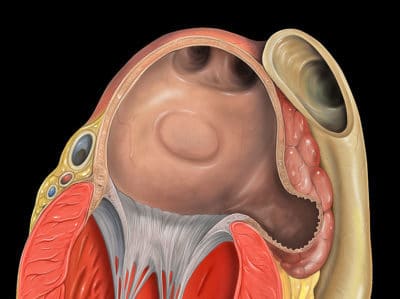
Editorial Credits to Mr Steven Hunter and Mr Inder Birdi
The left atrial appendage (LAA) is a small out-pouching of one of the chambers of the heart called the left atrium and is a major source of stroke forming clot in patients with atrial fibrillation. It looks like a cat’s ear and its function remains unclear in normal hearts which beat regularly.
When a person develops atrial fibrillation, the heart starts to beat in a haphazard fashion leading a reduction in the efficiency of cardiac function. This leads to symptoms of irregular heart beat or palpitations, shortness of breath, dizziness, and lethargy. Stasis of blood within the left atrium and especially in the LAA leads to the development of clots which can fly out of the heart and into the brain causing stroke. As the atrial fibrillation continues, the left atrium dilates and leads to the development of leaking heart valves which further exacerbate the situation.
Patients with atrial fibrillation are 5 times more likely to develop stroke without adequate treatment. This usually requires taking a blood thinner such as warfarin or newer alternatives to warfarin. All of these drugs can increase the risk of bleeding tendency which can sometimes be a danger to life.
Many patients either do not like to take blood thinners or are intolerant to blood thinners. In these patients it is important to consider other forms of treatment to reduce the risk of clot formation within the heart.
In patients who do not have valve disorders, clot formation in atrial fibrillation occurs in the LAA. In over 90% of patients who have a stroke due to AF the cause of the stroke is the clot in the LAA, which breaks away and goes to the brain. With this concept in mind, modern treatments have concentrated on closure of the left atrial appendage either via a groin-based procedure (Watchman Device), or by minimally invasive (keyhole) LAA clip (Atriclip Device). These treatments can reduce the risk of stroke and remove the need to take blood thinners.
Watchman Device (Boston Scientific)
The WATCHMAN device is approved for use to reduce the risk of clot embolism in selected patients with atrial fibrillation who do not have associated valve disease.
The actual device is shaped like a parachute and is inserted into the LAA over a wire placed through the skin in the groin percutaneously. You will sometimes need a general anaesthetic for this procedure. The device is designed to seal off the LAA and thereby reduce clot formation.
The Watchman Device is not always successful, either because it cannot be safely deployed, or it does not completely occlude the LAA and therefore does not fulfil its primary goal. In these patients minimally invasive (keyhole) LAA Clip (Atriclip) is an option.
Postoperative Care Following Watchman Device Insertion:
The procedure requires you to stay in hospital overnight
A transoesophageal echocardiogram (TOE, echo through the mouth) will be performed to ensure adequate position of the device
You will need to take anticoagulation for 6 weeks. This usually entails the need for warfarin and aspirin
A repeat TOE will be performed at 6 weeks to ensure that the LAA is occluded.
If the LAA is successfully occluded: you will be allowed to stop your warfarin after 6 months and will then take aspirin and clopidogrel for 6 months. Following this period, we may be able to reduce you to aspirin alone.
If the LAA is NOT occluded: you will need to continue taking warfarin and have another TOE and follow-up appointment after 6 months. If the LAA is still not occluded, then we may have to continued blood thinner treatment.
If you are interested in treatment with the WATCHMAN device, please contact us and we will arrange for you to be seen at the specialist atrial fibrillation clinic.
Patients who should not undergo Watchman Device Procedure:
Patients who cannot take warfarin, aspirin, or clopidogrel
Patients who should not or cannot undergo heart catheterisation procedures
Patients with a left atrial appendage that is too large or too small to fit the Watchman Device
Watchman Device Brochure for patients can be found HERE
Minimally Invasive LAA Clip Procedure
This procedure is performed under a general anaesthetic. The surgeon uses a specially designed device like the Atriclip to place a secure clip onto the outside of the LAA using a minimally invasive camera under telescopic vision.
The procedure usually takes 15 to 30 minutes and has a much higher success rate than the Watchman Device (and other such similar devices).
Once we see that the LAA is occluded, you are much more likely to be able to discontinue warfarin after surgical occlusion.
Surgeons also occlude the LAA during other forms of heart surgery in patients with atrial fibrillation.
If you are interested in treatment by Minimally invasive LAA clip, please contact us and we will arrange for you to be seen at the specialist atrial fibrillation clinic. Click for CONTACT PAGE
AtriClip PRO2 Animation from Meditech on Vimeo.
Get in touch with our expert team at our London Heart Clinic.
